
The Southern Railway (SR), sometimes shortened to 'Southern', was a British railway company established in the 1923 Grouping. It linked London with the Channel ports, South West England, South coast resorts and Kent. The railway was formed by the amalgamation of several smaller railway companies, the largest of which were the London and South Western Railway (LSWR), the London, Brighton and South Coast Railway (LB&SCR) and the South Eastern and Chatham Railway (SE&CR). The construction of what was to become the Southern Railway began in 1838 with the opening of the London and Southampton Railway, which was renamed the London & South Western Railway.
A number of different numbering and classification schemes were used for locomotives and multiple units operated by British Railways (BR), and this page explains the principal systems. This section also covers the post-privatisation period, as the broad numbering and classification arrangements have not altered since the break-up of BR.
The Southern Railway took a key role in expanding the 660 V DC third rail electrified network begun by the London & South Western Railway. As a result of this, and its smaller operating area, its steam locomotive stock was the smallest of the 'Big Four' companies.
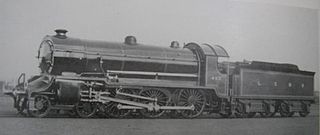
The LSWR/SR H15 class was a class of 2-cylinder 4-6-0 steam locomotives designed by Robert Urie for mixed-traffic duties on the LSWR. Further batches were constructed by Richard Maunsell for the Southern Railway after 1923. They were given the nickname of "Junior King Arthur" due to the size of their driving wheels, the S15 and their N15 cousins had driving wheels which had a diameter of 5 foot and 7 inches and 6 foot and 7 inches respectively.

Under the Whyte notation for the classification of steam locomotives, 0-4-4 represents the wheel arrangement of no leading wheels, four powered and coupled driving wheels on two axles, and four trailing wheels on two axles. This type was only used for tank locomotives.

The SR V class, more commonly known as the Schools class, is a class of steam locomotive designed by Richard Maunsell for the Southern Railway. The class was a cut down version of his Lord Nelson class but also incorporated components from Urie and Maunsell's LSWR/SR King Arthur class. It was the last locomotive in Britain to be designed with a 4-4-0 wheel arrangement, and was the most powerful class of 4-4-0 ever produced in Europe. All 40 of the class were named after English public schools, and were designed to provide a powerful class of intermediate express passenger locomotive on semi-fast services for lines which could cope with high axle loads but some of which had short turntables.
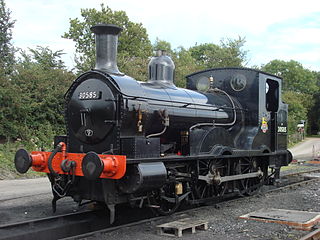
The London and South Western Railway (LSWR) 0298 Class or Beattie Well Tank is a class of British steam locomotive. They are 2-4-0WTs, originally built between 1863 and 1875 for use on passenger services in the suburbs of London, but later used on rural services in South West England. Out of a total production of 85, two locomotives have been preserved, both in operational condition.

The LSWR M7 class is a class of 0-4-4T passenger tank locomotive built between 1897 and 1911. The class was designed by Dugald Drummond for use on the intensive London network of the London and South Western Railway (LSWR), and performed well in such tasks. Because of their utility, 105 were built and the class went through several modifications over five production batches. For this reason there were detail variations such as frame length. Many of the class were fitted with push-pull operation gear that enabled efficient use on branch line duties without the need to change to the other end of its train at the end of a journey.
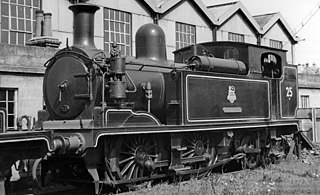
The LSWR O2 class is a class of 0-4-4T steam locomotive designed for the London and South Western Railway by William Adams. Sixty were constructed during the late nineteenth century. They were also the last steam engines to work on the Isle of Wight, with the final two being withdrawn in 1967. One has been preserved and is operational.

The LSWR S15 class is a British 2-cylinder 4-6-0 freight steam locomotive designed by Robert W. Urie, based on his H15 class and N15 class locomotives. The class had a complex build history, spanning several years of construction from 1920 to 1936. The first examples were constructed for the London and South Western Railway (LSWR), where they hauled freight trains to the south coast ports and further west to Exeter, as well as occasional passenger work in conjunction with their larger-wheeled N15 class counterparts.

The Q Class is a type of 0-6-0 steam locomotive designed by Richard Maunsell of the Southern Railway and constructed immediately prior to the Second World War for use on medium-distance freight trains throughout the network. Twenty locomotives were built by Maunsell's successor, Oliver Bulleid, in 1938. The design was relatively old-fashioned and the class was soon afterwards eclipsed by Bulleid's own more powerful Q1 class. Nevertheless the locomotives performed adequately and reliably on the tasks for which they had been designed, until their withdrawal in 1965. Only one has survived, and is preserved on the Bluebell Railway.
A number of different numbering and classification schemes were used for the locomotives owned by the London and North Eastern Railway (LNER) and its constituent companies. This page explains the principal systems that were used. The following abbreviations for the constituent companies are used on this page:
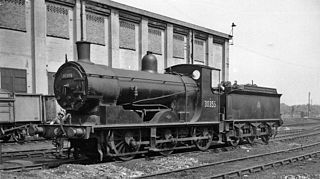
The LSWR 700 class was a class of 30 0-6-0 steam locomotives designed for freight work. The class was designed by Dugald Drummond in 1897 for the London and South Western Railway in England and built by Dübs and Company at that company's Queen's Park works at Polmadie, Glasgow, Scotland.

The LSWR 415 class is a 4-4-2T steam tank locomotive, with the trailing wheels forming the basis of its "Radial Tank" moniker. It was designed by William Adams and introduced in 1882 for service on the London and South Western Railway (LSWR).
This page explains the numbering and classification schemes for locomotives employed by the Japanese Government Railways, the Japanese National Railways and the Japan Railways Group.
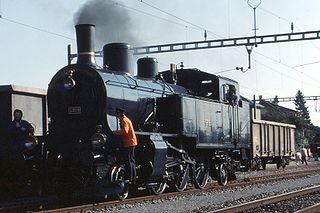
For more than a century, the Swiss locomotive, multiple unit, motor coach and railcar classification system, in either its original or updated forms, has been used to name and classify the rolling stock operated on the railways of Switzerland. It started out as a uniform system for the classification and naming of all rolling stock, powered and unpowered, but had been replaced and amended by the UIC classification of goods wagons.
The DRG locomotive classification system was developed by the German Imperial Railway Company or Deutsche Reichsbahn-Gesellschaft (DRG), which was formed in 1924 following the merger of the German state railways (Länderbahnen) in 1920. A common classification and numbering scheme was needed in order to organise effectively the four hundred or so different steam locomotive classes taken over from the state railways, as well as new locomotives. This process lasted until 1926. Only then was the final renumbering plan fixed.

The DR locomotive classification scheme in East Germany in the initial post-war period used the DRG system, consisting of a class number (Baureihennummer) followed by a serial number (Ordnungsnummer). With the introduction of computerised (EDP) numbers in 1970 as part of the UIC framework, the system was fundamentally changed for the first time.

From 1920, the cab side of Great Western Railway (GWR) steam locomotives bore a letter on a coloured disc, which enabled staff to quickly assess the capabilities of locomotives without the need to check tables of data. The letter showed the power classification, and the coloured disc showed the weight restriction. This system continued after the GWR became the Western Region of British Railways.
In the first 36 years of its existence, the NSW Railways introduced 42 separate classes of locomotives. The appointment by the Premier of New South Wales, Henry Parkes of Mr E.M.G Eddy as Chief Commissioner in 1888 created an independent railway department and saw the following 36 years with only sixteen new classes produced.













